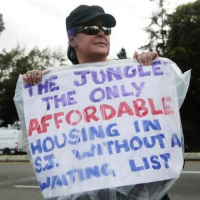Hundreds Kicked out of Homeless Encampment in Silicon Valley
 Moving day at the Jungle (photo: Marcio Jose Sanchez, Associated Press)
Moving day at the Jungle (photo: Marcio Jose Sanchez, Associated Press)
San Jose authorities tore down the Jungle Thursday, arguably the nation’s largest homeless encampment, nestled among the affluent surroundings of Silicon Valley.
Between 200 and 300 people were peacefully cleared out of the sprawling 68-acre shantytown, around 140 of them reportedly headed for some kind of subsidized housing arranged by the county and nonprofit organizations. Another 50 have housing vouchers but haven’t used them yet.
But many will end up on the street. They will join the estimated 7,630 homeless people in San Jose and Santa Clara County who camp out wherever they can. It’s said to be the largest percentage of nonsheltered homeless people in a big city.
Mother Jones says there are 247 tent cities in the county and many of the occupants have jobs. They just don’t make enough money to afford housing and won’t be renting anytime soon within 10 miles of San Jose, where the Los Angeles Times says the average apartment rental has soared from $1,761 a month to $2,633.
A 2013 survey (pdf) of homelessness in Santa Clara County found it was a new experience for 46% of the respondents and 56% had been without a home for more than a year. They were not out-of-towners. Eight-seven percent said they lived in the county when they became homeless and 50% had been in San Jose. The survey identified 718 veterans among the homeless, around 9.4%. Two hundred and three unaccompanied kids under 18 were counted, as well as 1,063 youths between the ages of 18 and 24.
Only 26% of the county’s homeless are sheltered in facilities. Thirty-one percent are on the street, 19% are in encampments, 16% live in vehicles and 9% sleep in abandoned buildings.
When Mother Jones writers took a tour of the Jungle, they bumped into folks not far removed from more comfortable accommodations in Silicon Valley. Robert Aguirre, a 60-year-old unemployed electrical engineer, has been living there for six months. He used to own a home and do tech consulting for Apple, Dell and Cisco in the 1990s before corporate outsourcing to China dried up his employment prospects.
His handicapped wife is a medical clerk who makes $3,000 a month. They got bumped from their apartment and ended up living in their car for two months before moving to the Jungle. “We're really not making enough money to afford conventional housing, yet we make too much money for subsidized homes. So we're kind of floating between the oil and water somewhere in there,” Aguirre said.
The beginning of the end for the Jungle came earlier in the year when California’s Department of Fish and Wildlife officially complained to the city about polluting homeless encampments along Coyote Creek. A deal was worked out with the San Francisco Bay Regional Water Quality Control Board for a December closure and the authorities announced they were going to tear down the encampment in September.
Warning signs went up on Monday and police, homeless outreach workers and officials from the Santa Clara County Water District moved in three days later. The water district owns the property. San Francisco Baykeeper, an environmental group, announced on Monday that it would file a lawsuit over excessive trash and bacterial pollutants in the creek.
–Ken Broder
To Learn More:
The Jungle: San Jose Shuts Notorious Homeless Encampment (by Mark Emmons, San Jose Mercury News)
San Jose’s "Jungle" Homeless Encampment Cleared (by Kale Williams, San Francisco Chronicle)
San Jose Begins Closing Down 68-Acre Homeless Encampment (by Rong-Gong Lin II and Gale Holland, Los Angeles Times)
Hanging Out With the Tech Have-Nots at a Silicon Valley Shantytown (by Josh Harkinson, Mother Jones)
The Jungle: Thousands of Homeless People Live in Shantytowns at the Epicenter of High-Tech, Super-Rich Silicon Valley (by Evelyn Nieves, Alternet)
2013 Santa Clara County Homeless Census and Survey (Applied Survey Research) (pdf)
- Top Stories
- Controversies
- Where is the Money Going?
- California and the Nation
- Appointments and Resignations
- Unusual News
- Latest News
- California Forbids U.S. Immigration Agents from Pretending to be Police
- California Lawmakers Urged to Strip “Self-Dealing” Tax Board of Its Duties
- Big Oil’s Grip on California
- Santa Cruz Police See Homeland Security Betrayal in Use of Gang Roundup as Cover for Immigration Raid
- Oil Companies Face Deadline to Stop Polluting California Groundwater





